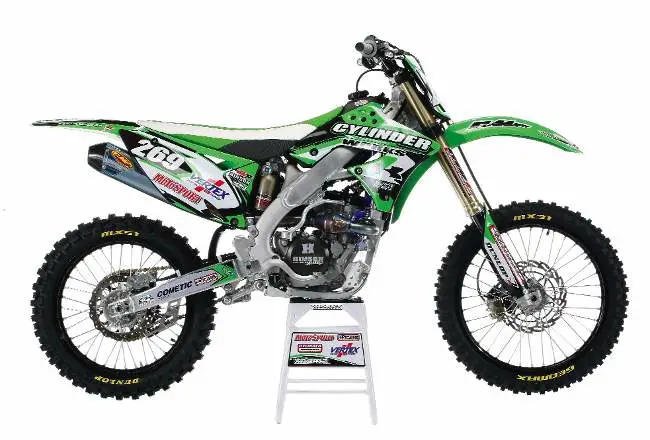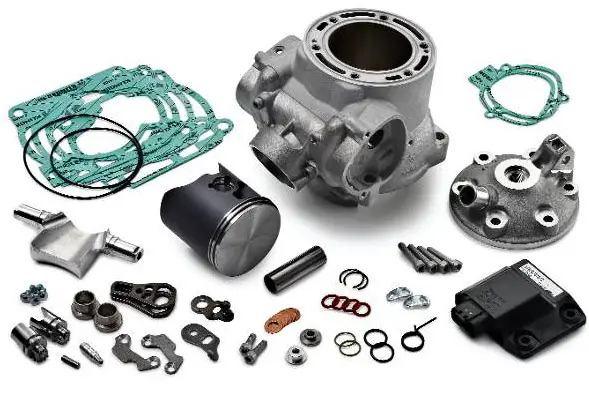MXA WRENCH TECH: THE INS AND OUTS OF BIG-BORE ENGINES


Big-bore kits are available from Cylinder Works, Wiseco, CP, L.A. Sleeve, Millennium, Thumper Racing, KTM, GYTR and Athena. This bike is a KX250F turned into a KX269 by Cylinder Works.
When you increase the cylinder’s bore you increase the surface area on top of the piston. This spreads the fuel/air mixtures workload and produces more power without taxing the force of combustion. Even with standard cranking pressure you gain better performance because of the extra size of the combusted explosion. Conversely, to make more power with a standard-size bore requires that you compress the constrained explosion with more pressure. More compression forces the engine to work harder, resulting in more stress and an engine that wears out quicker.
Making horsepower with a bigger bore has no major effects on reliability (unless you exceeded the tipping point). Running the standard compression means that you can use 91-octane pump gas. A bore increase equal in thickness to a dime turns a 250F into a 269. The power increase from those 19cc cost less and is easier to come by than adding valves, porting, pipe and carburetor mods all together.

The KTM 300cc kit for the 250SX. It costs $950.
Bigger isn’t always better. If 269cc is good it doesn’t mean that 292cc is going to be proportionally better. No. Why not? All engine configurations have a “tipping point.” It’s the point at which the bore gets too big for the length of the stroke. If you go too big on the bore you will lose revs and change the power characteristics (and not always for the better). There is no magic formula to find the exact moment of tipping. Each engine has its own set of design nuances and each one responds differently to an increase in bore. The only way to find out is through trial and error.


Millennium Technologies CRF264 kit (with a CP piston).
Additionally, if you bore the cylinder too big, the wall thickness of the stock cylinder gets too thin and the cylinder loses stability. As the piston bangs its way up and down, it pounds the cylinder bore out of round. Round pistons and oval bores aren’t a good power match. Even worse, the cylinder will warp and will leak air and oil at a head or base gasket. That is why several companies make big-bore kits with brand new cast cylinders.
What is the best size four-stroke to bore out? The most effective big-bore engine is the 250 four-stroke. By going to a bigger piston, enough to get it up to 270cc that can add as much as three horsepower.


The Athena makes big-bore kits for a wide variety of bike?this is a CRF450 kit to turn it into a CRF470.
What about big-bore 450s? A two millimeter larger piston will give a 450 a final displacement of 469cc. It’s a significant improvement that gives more power everywhere. The most obvious rider to benefit from a big-bore 450 are large riders?we mean overweight riders who’s extra cargo benefits from some extra ponies.
Will the stock jetting work with a big-bore cylinder? In most cases yes, but as a rule of thumb, the smaller the engine size the more jetting help it will need. With 50cc, 90cc, 110cc and 125cc minis you need a carburetor upgrade to go along with the big bore. If you really want to make the most of that 143cc kit on your KLX110, you’ll need to switch the stock 18mm Keihin for a 26mm Mikuni or 28mm Keihin. On the bigger machinery the stock carb will almost always support the bore increase. So much so that in many cases you will need to jet down! It may seem counter to common sense, but a larger engine draws more air, which in turn drops more pressure, sucks harder and pulls more gas out of the float bowl thanks to Bernoulli’s principle. Often you will need to drop the needle one clip and go one size leaner on the pilot. In the case of fuel injection, mapping will iron out any wrinkles.


The popularity of the KTM 150SX has led to several YZ125 to YZ144 kits (plus TM and Husky sell ready-made 150s).
Who should be thinking about buying a big-bore engine? There are four main groups:
(1) Cheaters who want an advantage over other riders. You can only really cheat with a big-bore in the mini or 250F classes. Big-boring a 450 four-stroke or a 250cc two-stroke is considered to be a protest against the AMA–not cheating.
(2) Vets who would like to ride a light motorcycle without giving up massive ponies to their CRF450-mounted competitors. Many Vets choose to race big-bore 250 four-strokes because they are lighter, smaller and more fun to ride.
(3) Professional practice riders who aren’t bound by a rule book can ride anything they want.
(5) Mechanically unlucky riders often big-bore their engines when it comes time to rebuild them after a blowup. Why? They have to buy the parts anyway, so going big seems like a good way to get more for your money than just a replacement for your old mill.


Big-bore kits are available for everything from CRF50’s to 250F’s to 450’s and for most two-strokes. This is an Yamaha YZ270 kit.




Comments are closed.